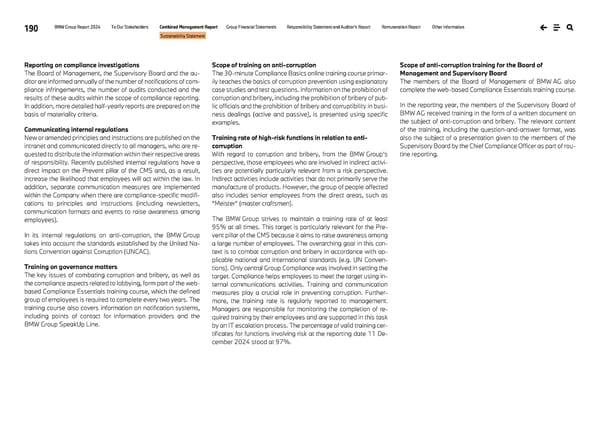190 BMW Group Report 2024 To Our Stakeholders Combined Management Report Group Financial Statements Responsibility Statement and Auditor’s Report Remuneration Report Other Information Sustainability Statement Reporting on compliance investigations The Board of Management, the Supervisory Board and the au- ditor are informed annually of the number of notifications of com- pliance infringements, the number of audits conducted and the results of these audits within the scope of compliance reporting. In addition, more detailed half-yearly reports are prepared on the basis of materiality criteria. Communicating internal regulations New or amended principles and instructions are published on the intranet and communicated directly to all managers, who are re- quested to distribute the information within their respective areas of responsibility. Recently published internal regulations have a direct impact on the Prevent pillar of the CMS and, as a result, increase the likelihood that employees will act within the law. In addition, separate communication measures are implemented within the Company when there are compliance-specific modifi- cations to principles and instructions (including newsletters, communication formats and events to raise awareness among employees). In its internal regulations on anti-corruption, the BMW Group takes into account the standards established by the United Na- tions Convention against Corruption (UNCAC). Training on governance matters The key issues of combating corruption and bribery, as well as the compliance aspects related to lobbying, form part of the web- based Compliance Essentials training course, which the defined group of employees is required to complete every two years. The training course also covers information on notification systems, including points of contact for information providers and the BMW Group SpeakUp Line. Scope of training on anti-corruption The 30-minute Compliance Basics online training course primar- ily teaches the basics of corruption prevention using explanatory case studies and test questions. Information on the prohibition of corruption and bribery, including the prohibition of bribery of pub- lic officials and the prohibition of bribery and corruptibility in busi- ness dealings (active and passive), is presented using specific examples. Training rate of high-risk functions in relation to anti- corruption With regard to corruption and bribery, from the BMW Group’s perspective, those employees who are involved in indirect activi- ties are potentially particularly relevant from a risk perspective. Indirect activities include activities that do not primarily serve the manufacture of products. However, the group of people affected also includes senior employees from the direct areas, such as “Meister” (master craftsmen). The BMW Group strives to maintain a training rate of at least 95% at all times. This target is particularly relevant for the Pre- vent pillar of the CMS because it aims to raise awareness among a large number of employees. The overarching goal in this con- text is to combat corruption and bribery in accordance with ap- plicable national and international standards (e.g. UN Conven- tions). Only central Group Compliance was involved in setting the target. Compliance helps employees to meet the target using in- ternal communications activities. Training and communication measures play a crucial role in preventing corruption. Further- more, the training rate is regularly reported to management. Managers are responsible for monitoring the completion of re- quired training by their employees and are supported in this task by an IT escalation process. The percentage of valid training cer- tificates for functions involving risk at the reporting date 11 De- cember 2024 stood at 97%. Scope of anti-corruption training for the Board of Management and Supervisory Board The members of the Board of Management of BMW AG also complete the web-based Compliance Essentials training course. In the reporting year, the members of the Supervisory Board of BMW AG received training in the form of a written document on the subject of anti-corruption and bribery. The relevant content of the training, including the question-and-answer format, was also the subject of a presentation given to the members of the Supervisory Board by the Chief Compliance Officer as part of rou- tine reporting.
 BMW Group Report 2024 Page 189 Page 191
BMW Group Report 2024 Page 189 Page 191